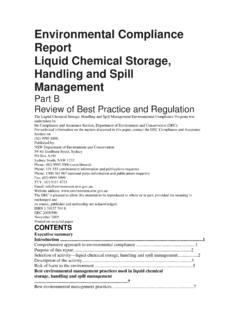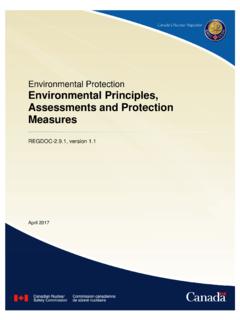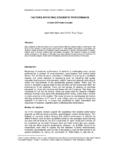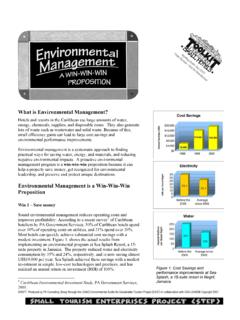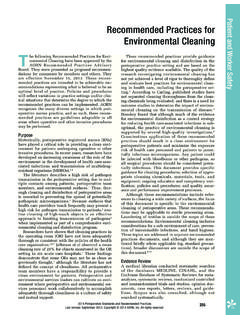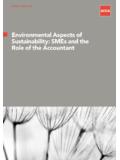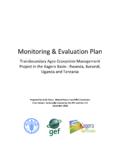Transcription of SWITZERLAND - OECD.org
1 SWITZERLANDCONCLUSIONS AND RECOMMENDATIONS (see next page) ..OUTLINE OF THE IPOLLUTION CONTROL AND NATURE OF NATURE, LANDSCAPES AND IIINTEGRATION OF AND THE INTEGRATION: INTEGRATION: IIICO-OPERATION WITH THE INTERNATIONAL AND RECOMMENDATIONS* SWITZERLAND s environment is under intense pressure (pollution, natural resource use, spatial restructuring)notably from industry, agriculture, transport and tourism. These pressures reflect very high densities of populationand activity as well as a location in the heart of Europe. SWITZERLAND nevertheless still has remarkable natural sceneryand wilderness the 1970s and 1980s ambitious environmental policies promoted by the Confederation wereimplemented by the cantons and municipalities. Fundamental to these polices were a regulatory approach, substantialgovernment funding and an actively involved public demonstrating great environmental awareness (following severalindustrial accidents and the debate on forest decline).
2 Remarkable results to pollution abatement were achieved the beginning of the 1990s environmental policies have focused on prevention of damage to theenvironment, application of the polluter pays principle and collaboration with the business community. The FederalCouncil recently confirmed its intention to consider the requirements of sustainable development in all sectoralpolicies, notably those affecting energy, transport and agriculture. However, SWITZERLAND must overcome two majorobstacles: the difficulty of translating the concept of sustainable development into actual changes in consumption andproduction patterns, and the tendency for concerns about economic stagnation, employment and competitiveness tolower the priority given to environmental OECD report establishes a baseline for assessing future environmental progress and reviewsSwitzerland s environmental performance in three areas: implementation of environmental policies; integration of environmental concerns in economic decision-making.
3 And international co-operation in environmental of Environmental PoliciesEnvironmental effectiveness and economic efficiencyAmbitious policies and very good results in pollution controlSwitzerland has designed and implemented pollution abatement policies with ambitious objectives. Mostof these objectives have been met with remarkable success: air pollution emission rates among the lowest in theOECD area, very high levels of waste water infrastructure and in waste management facilities. This success wasachieved by means of an ambitious regulatory approach combined with rigorous enforcement, strong support from thepublic and a considerable financial prescriptive environmental policy applied in SWITZERLAND rests on a very comprehensive body offederal and cantonal laws and regulations. Their enactment is preceded by lengthy and intensive consultationsbetween the different authorities and economic actors, which facilitates their implementation and involvement is very developed.
4 Citizens may intervene in the preparation of legislation, proposesubjects for referendums and vote directly on major policy issues. A number of referendums have been decisive instrengthening environmental action. As regards right of redress, the prominent NGOs have extensive possibilitieswhich it is important that they on environmental protection is equivalent to about per cent of a GDP which is highcompared with that of other OECD countries. The Confederation, cantons and municipalities finance roughly one-third of this expenditure, businesses and households roughly SWITZERLAND is one of the OECD countries that has invested most in environmental protection,much remains to be done. Concerning grey environmental issues, it is necessary to meet air management targets * Conclusions and Recommendations approved by the Group on Environmental Performance at its June 1998 NOx, VOCs and ozone, maintain and renovate waste water infrastructure, supplement municipal and industrialwaste management infrastructure, clean up contaminated sites, treat non-point source pollution, regulate geneticengineering, and so on.
5 As regards green environmental issues, despite some successes such as the stabilisation offorested area, measures to protect, nature, landscapes and biodiversity have been insufficient to counteract thepressures of economic activity in a country notable for its population density and its highly-developed tourismindustry. These measures therefore need to be reinforced, particularly at cantonal the economic efficiency of environmental policiesSwitzerland s environmental policies are now at a critical juncture characterised by rapidly rising marginalcosts of pollution abatement, sluggish economic activity, public budget restrictions, concerns about competitivenessin Europe, and globalisation. As a result, SWITZERLAND is seeking and should continue to seek greater economicefficiency in its environmental policies and consistency of its environmental law with European has accordingly revised and modernised its Constitution and its various laws concerning theenvironment.
6 It is moving towards a more balanced use of sets of regulatory, economic and voluntary measures. Theprinciple of causality has been adopted with the aim of internalising external costs, and several economic instrumentshave been introduced. The new charges on VOCs and on the sulphur content of heating fuel are very promising inthat they are fiscally neutral and highly incentive. Nevertheless, the number of economic instruments used inenvironmental policies in SWITZERLAND is comparatively modest. In accordance with the principle of collaboration,several voluntary agreements with industry have been adopted, thus permitting flexible progress towardsenvironmental analysis and evaluation of environmental policies is still relatively little developed inSwitzerland, despite a recent expansion of research capabilities in this area.
7 There is a shortage of data on the resultsand implementation of environmental protection measures in the cantons and municipalities, expenditure incurred,checks and sanctions applied, and the effects of eco-taxes and of green payments to farmers. The Confederationtherefore must not confine itself to promoting policies, but must also monitor is recommended that consideration be given to the following proposals: continue efforts to apply the principle of causality (polluter pays and user pays principles) and reducesubsidies for pollution abatement; raise the rates of existing charges and taxes progressively so as to internalise externalities that areinsufficiently taken into account; introduce new economic instruments without increasing fiscalpressure; encourage monitoring of results and assessment of the economic efficiency of environmental policieson the basis of more comprehensive and comparable data concerning individual cantons andmunicipalities, for example on pollutant emissions, expenditure on environmental protection, anddegrees of target attainment; continue efforts to apply the principle of collaboration with the parties concerned, in particular bydeveloping voluntary agreements with the business community together with involvement andinformation of the public; develop preventive action and land use planning, especially as regards non-point source pollution andthe protection of nature, landscapes and took measures very early on to prevent and control water pollution, notably from industrialand urban sources.
8 There has been considerable investment in waste water infrastructure (over SF 40 billion in thepast 30 years), partly financed by federal and cantonal subsidies. As a result, many watercourses are now of goodphysical-chemical quality (content of organic contaminants, heavy metals and micro-pollutants). With the ban onphosphates in detergents, and phosphate removal at many treatment plants, phosphate loads from these sources havedecreased very significantly. SWITZERLAND is also very active in the management of lakes and river basins of new generation of water management policies has been developed to solve remaining problems. First,the new water pricing system will enable the implementation of the principle of causality and will provide economicincentives for better management of water resources. Maintenance and renewal of the sewerage network will requireconsiderable and sustained financial efforts.
9 Second, control of non-point source pollution has fallen behind. Theoverall phosphate load has remained the same due to the increasing load from agricultural sources, and eutrophicationis still a major concern for most lakes. Nitrate concentrations in groundwater continue to increase. Many drinkingwater catchment points need to be better protected from pollution by nitrates and pesticides. Third, flood control,power generation and urban development have in many cases disrupted the morphology and biological life ofwatercourses. The recent introduction of minimum flows downstream from water withdrawal points is only a partialsolution. Fourth, integrated, partnership-based management could be encouraged so as to ensure sustainabledevelopment of water is recommended that consideration be given to the following proposals: continue to implement the new water pricing system; envisage the application of new economicinstruments such as effluent charges and taxes on polluting agricultural inputs; ensure funding for the maintenance and renewal of waste water treatment facilities; accelerate the application of measures to control non-point source pollution, notably from agriculture; improve the protection of withdrawal points for drinking water supply, for example against harmful orpersistent substances (nitrates, pesticides); give higher priority to the restoration of watercourses; improve target definition in this area and seek abroad consensus in regard to such programmes.
10 Speed up improvement of the federal network for monitoring groundwater quality so as to obtain abetter understanding of trends in this area, as well as of the influence of measures taken in othersectors such as agriculture; with a view to sustainable development of water resources, develop a system of integrated,partnership-based management for all water users; this should include inter-sectoral interests andpolicies such as nature and performance as regards air quality is among the best. SWITZERLAND has met or will shortly meet all itsinternational commitments for atmospheric emissions reduction. Since the early 1980s it has achieved remarkabledeclines in emissions of the main air pollutants (SOx, NOx, VOCs, CO, particulates, heavy metals) and substantialimprovements in air quality.










